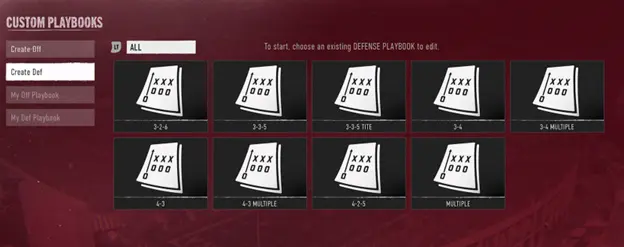College Football 25 ディフェンシブフォーメーション
Quick Formation Choice Table
Each defensive formation in CFB25 is built for a different situation. Mastering defense isn't just about picking plays, it's about matching formations to the offense you're facing. Start by learning a few base formations like 4-3 and Nickel, and build up from there as you get more comfortable reading offenses.
| Situation | Recommendation |
|---|---|
Situation 1st & 10 / Balanced | Recommendation 4-3, 3-4, 4-2-5 |
Situation Obvious Run (3 yards or less) | Recommendation Goal Line, 4-3, 3-4 |
Situation Spread Offense (3+ WRs) | Recommendation Nickel, 4-2-5, 3-3-5 |
Situation 3rd & Long | Recommendation Dime, Nickel |
Situation Mobile QB | Recommendation 3-3-5, 4-2-5, Spy with LB or Safety |
Situation Red Zone Defense | Recommendation Goal Line, 4-3 with Zone or man coverage |
CFB25 Defensive Formations Guide
In CFB25, choosing the right defensive formation is key to shutting down your opponent. Each formation is designed to match up against different offensive looks and knowing their strengths and weaknesses helps you call smarter plays. Any of the number naming conventions show how many Defensive Linemen first, then how many Linebackers, then how many Defensive Backs.

CFB 25 What is a Shell and How do I Change My Shell?
In College Football 25 you can change your shell by viewing the Plays by Formation tab and moving your right stick to the right and left. The shell indicator is in the bottom line crawler.
Your shell will disguise your coverage to keep your opponent guessing. Play Cover 3 coverage in a Cover 1 shell to confuse your matchup.

4-3 Defense (4 DLine, 3 Linebackers)
Best for stopping the run while still defending the pass.
Strengths:
- Balanced against run and pass
- Strong front four for shedding blocks and getting pressure
- Good linebacker support for run fits and short zones
Weaknesses:
- Can struggle vs spread formations with lots of WRs
- Linebackers must cover a lot of ground in coverage
Nickel Defense (5 Defensive Backs, 4 DLine, 2 Linebackers)
Best for defending against 3+ WR sets and passing downs.
Strengths:
- Extra DB helps cover additional receivers
- Great against spread and shotgun formations
- Often includes fast sub-packages for better speed on the field.
Weaknesses:
- A lighter front may struggle against inside runs
- Fewer linebackers means weaker underneath zone coverage vs TEs and RBs
Dime Defense (6 Defensive Backs, 4 DLine, 1 Linebackers)
Best for obvious passing downs (3rd & long)
Strengths:
- Maximum pass coverage with extra safeties and corners
- Great for shutting down deep routes or Hail Mary attempts
Weaknesses:
- Very weak against the run
- Velnerable to screens, draws, or short yardage power plays.
Goal Line Defense (Heavy front with 5-6 DLine or TEs as defenders)
Best for: 3 yards or less, especially near the end zone.
Strengths:
- Extremely strong vs power run plays
- Forces the offense to beat you through the air in tight space
Weaknesses:
- Almost no coverage help - easy to beat with play action or quick passes
- Not usable outside of short-yardage or goal-line situations.
4-2-5 Defense (4 DLine, 2 LBs, 5 DBs - hybrid between 4-3 and Nickel)
Best for: Spread offenses with a mix of run and pass.
Strengths:
- Balanced speed and coverage
- Extra DB helps defend modern college offenses
- Versatile enough to handle both dual-threat QBs and air raid schemes
Weaknesses:
- Fewer LBs may weaken the run defense if DL can' win upfront
- Requires skilled hybrid safeties or nickelbacks to cover and tackle well
3-3-5 Defense (3 DLine, 3 LBs, 5 DBs)
Best for: Flexibility vs spread and mobile QBs.
Strengths:
- Excellent disguise formation
- Can quickly shift to cover or blitz from multiple angles
- Great against dual-threat QBs and fast-paced offenses
Weaknesses:
- Needs disciplined gap control to stop the run
- Relies heavily on fast, smart LBs and safeties
